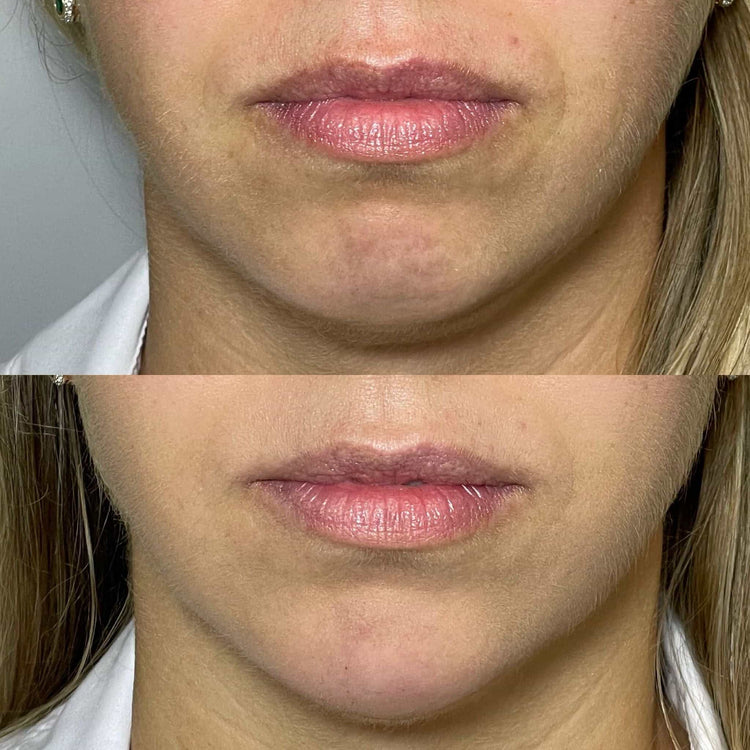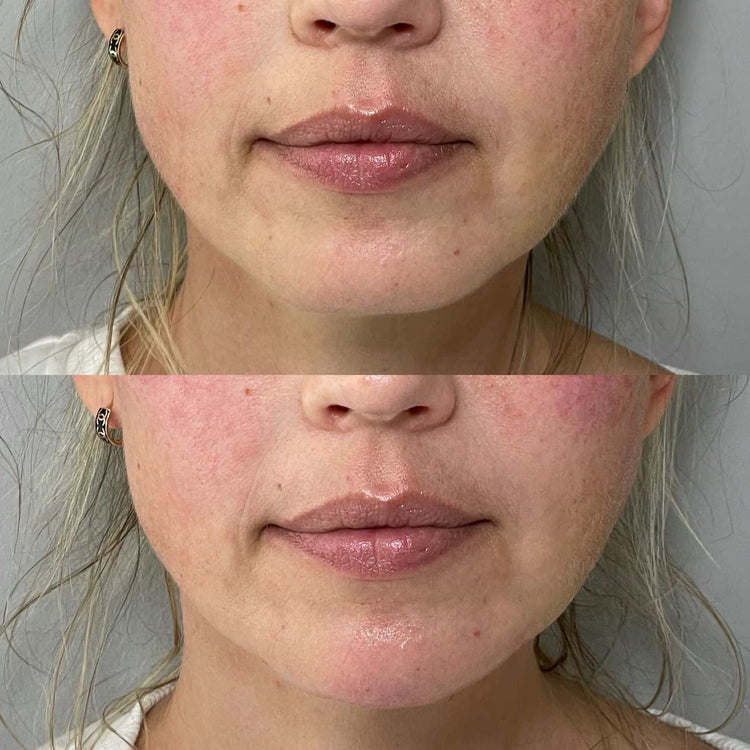Asymmetrical Results
Achieving symmetrical facial aesthetics is key in aesthetic medicine, and lip augmentation treatments are no exception. Asymmetrical results can be a significant concern for patients who seek balanced and harmonious facial features. Understanding the telltale signs of unevenly placed or improperly injected filler can empower individuals to make informed decisions about their aesthetic choices and ensure they achieve the desired outcome.
Uneven Shape
A lack of symmetry is often one of the most noticeable signs of a poorly executed labiomental crease filler treatment. Look for discrepancies in the height, fullness, or shape of the creases on either side of the mouth. Uneven contours can create an imbalanced appearance and detract from the overall aesthetic effect.
Asymmetry can manifest as one side appearing higher or fuller than the other, resulting in a “pulled” or tilted look. Conversely, if one side appears sunken or lacking volume, it can make the face appear asymmetrical.
Differing Volumes
Another indicator of a poorly executed treatment is differing volumes on either side.
This means that one side might have significantly more filler than the other, leading to an unnatural and uneven appearance.
Visible Lumps or Nodules
Visible lumps or nodules can signal trouble with labiomental crease filler placement. These irregularities beneath the skin are often a result of filler being injected too superficially or inadequately dispersed.
Hard or Firm Texture
Visible lumps or nodules can signal trouble with labiomental crease filler placement. These irregularities beneath the skin are often a result of filler being injected too superficially or inadequately dispersed.
- Hard or firm texture:
If you notice hard or firm areas in the treated area, it could indicate that the filler hasn’t been properly integrated into surrounding tissues. This can result in a lumpy appearance and may also suggest uneven distribution.
Puckering or Bulges
Puckering or bulges are additional signs to watch out for. These occur when filler is not smoothly injected, leading to unnatural elevations or depressions in the skin.
These imperfections can distort the natural contours of the labiomental crease and create an unappealing, uneven appearance.
Migration of Filler
Achieving symmetrical facial aesthetics is crucial in aesthetic medicine, especially when it comes to lip augmentation treatments. Asymmetrical results can significantly impact a patient’s satisfaction, as they seek balanced and harmonious features. Recognizing the subtle yet telltale signs of poorly executed labiomental crease filler treatments empowers individuals to make informed decisions about their aesthetic choices.
Filler Shifting to Other Areas
Filler migration is when the injected filler material moves from its intended location. This can occur due to several factors, such as excessive force during injection, improper injection technique, or natural body movement.
Filler shifting to other areas can result in an unnatural appearance and may lead to asymmetry.
For instance, if filler is injected into the labiomental crease but migrates upwards towards the lips, it can create a “stretched” or elongated appearance to the upper lip.
Conversely, if filler migrates downwards, it can cause an unnatural fullness in the chin area.
It’s important to choose a qualified and experienced injector who understands proper injection techniques and anatomical structures to minimize the risk of filler migration.
Discoloration or Streaking
Discoloration or streaking can also indicate a poorly done labiomental crease filler treatment. These visual imperfections appear as bluish, reddish, or even brownish hues within the treated area.
- Color changes are often caused by blood vessels reacting to the injection or filler particles settling unevenly.
Streaking can arise from filler being injected too superficially or if it doesn’t blend seamlessly with surrounding tissues.
Overfilled Lips
Achieving symmetrical facial aesthetics is key in aesthetic medicine, and lip augmentation treatments are no exception. Asymmetrical results can be a significant concern for patients who seek balanced and harmonious facial features. Understanding the telltale signs of unevenly placed or improperly injected filler can empower individuals to make informed decisions about their aesthetic choices and ensure they achieve the desired outcome.
Unnaturally Full Appearance
Achieving symmetrical facial aesthetics is key in aesthetic medicine, and lip augmentation treatments are no exception. Asymmetrical results can be a significant concern for patients who seek balanced and harmonious facial features. Understanding the telltale signs of unevenly placed or improperly injected filler can empower individuals to make informed decisions about their aesthetic choices and ensure they achieve the desired outcome.
A lack of symmetry is often one of the most noticeable signs of a poorly executed labiomental crease filler treatment. Look for discrepancies in the height, fullness, or shape of the creases on either side of the mouth. Uneven contours can create an imbalanced appearance and detract from the overall aesthetic effect.
Asymmetry can manifest as one side appearing higher or fuller than the other, resulting in a “pulled” or tilted look. Conversely, if one side appears sunken or lacking volume, it can make the face appear asymmetrical.
Another indicator of a poorly executed treatment is differing volumes on either side.
This means that one side might have significantly more filler than the other, leading to an unnatural and uneven appearance.
Visible lumps or nodules can signal trouble with labiomental crease filler placement. These irregularities beneath the skin are often a result of filler being injected too superficially or inadequately dispersed.
- Hard or firm texture:
If you notice hard or firm areas in the treated area, it could indicate that the filler hasn’t been properly integrated into surrounding tissues. This can result in a lumpy appearance and may also suggest uneven distribution.
Puckering or bulges are additional signs to watch out for. These occur when filler is not smoothly injected, leading to unnatural elevations or depressions in the skin.
These imperfections can distort the natural contours of the labiomental crease and create an unappealing, uneven appearance.

Filler migration is when the injected filler material moves from its intended location. This can occur due to several factors, such as excessive force during injection, improper injection technique, or natural body movement.
Filler shifting to other areas can result in an unnatural appearance and may lead to asymmetry.
For instance, if filler is injected into the labiomental crease but migrates upwards towards the lips, it can create a “stretched” or elongated appearance to the upper lip.
Conversely, if filler migrates downwards, it can cause an unnatural fullness in the chin area.
It’s important to choose a qualified and experienced injector who understands proper injection techniques and anatomical structures to minimize the risk of filler migration.
Discoloration or streaking can also indicate a poorly done labiomental crease filler treatment. These visual imperfections appear as bluish, reddish, or even brownish hues within the treated area.
- Color changes are often caused by blood vessels reacting to the injection or filler particles settling unevenly.
Streaking can arise from filler being injected too superficially or if it doesn’t blend seamlessly with surrounding tissues.
Achieving symmetrical facial aesthetics is key in aesthetic medicine, and lip augmentation treatments are no exception. Asymmetrical results can be a significant concern for patients who seek balanced and harmonious facial features. Understanding the telltale signs of unevenly placed or improperly injected filler can empower individuals to make informed decisions about their aesthetic choices and ensure they achieve the desired outcome.
Loss of Definition
A lack of symmetry is often one of the most noticeable signs of a poorly executed labiomental crease filler treatment. Look for discrepancies in the height, fullness, or shape of the creases on either side of the mouth. Uneven contours can create an imbalanced appearance and detract from the overall aesthetic effect.
Asymmetry can manifest as one side appearing higher or fuller than the other, resulting in a “pulled” or tilted look. Conversely, if one side appears sunken or lacking volume, it can make the face appear asymmetrical.
Another indicator of a poorly executed treatment is differing volumes on either side.
This means that one side might have significantly more filler than the other, leading to an unnatural and uneven appearance.
Visible lumps or nodules can signal trouble with labiomental crease filler placement. These irregularities beneath the skin are often a result of filler being injected too superficially or inadequately dispersed.
- Hard or firm texture:
If you notice hard or firm areas in the treated area, it could indicate that the filler hasn’t been properly integrated into surrounding tissues. This can result in a lumpy appearance and may also suggest uneven distribution.
Puckering or bulges are additional signs to watch out for. These occur when filler is not smoothly injected, leading to unnatural elevations or depressions in the skin.
These imperfections can distort the natural contours of the labiomental crease and create an unappealing, uneven appearance.
Filler migration is when the injected filler material moves from its intended location. This can occur due to several factors, such as excessive force during injection, improper injection technique, or natural body movement.
Filler shifting to other areas can result in an unnatural appearance and may lead to asymmetry.
For instance, if filler is injected into the labiomental crease but migrates upwards towards the lips, it can create a “stretched” or elongated appearance to the upper lip.
Conversely, if filler migrates downwards, it can cause an unnatural fullness in the chin area.
It’s important to choose a qualified and experienced injector who understands proper injection techniques and anatomical structures to minimize the risk of filler migration.
Discoloration or streaking can also indicate a poorly done labiomental crease filler treatment. These visual imperfections appear as bluish, reddish, or even brownish hues within the treated area.
- Color changes are often caused by blood vessels reacting to the injection or filler particles settling unevenly.
Streaking can arise from filler being injected too superficially or if it doesn’t blend seamlessly with surrounding tissues.

Infection Signs
Recognizing the subtle yet telltale signs of poorly executed labiomental crease filler treatments is crucial for achieving symmetrical and aesthetically pleasing results. Uneven filler distribution, lumps, puckering, and discoloration can all signal a subpar treatment. Understanding these indicators empowers individuals to make informed decisions about their aesthetic choices and ensure they achieve the desired outcome.
Swelling and Redness Beyond the Treatment Area
Infection signs like redness and swelling extending beyond the treated area are serious indicators of complications following a labiomental crease filler treatment. This expansion of inflammation suggests that the body is reacting to an infection, potentially indicating improper sterilization techniques, allergic reactions to the filler, or the introduction of bacteria during the procedure.
These signs should never be ignored and require immediate attention from a medical professional.
Prompt treatment can help prevent further complications and ensure proper healing.
Pain, Tenderness, or Warmth
Recognizing the subtle yet telltale signs of poorly executed labiomental crease filler treatments is crucial for achieving symmetrical and aesthetically pleasing results. Uneven filler distribution, lumps, puckering, and discoloration can all signal a subpar treatment. Understanding these indicators empowers individuals to make informed decisions about their aesthetic choices and ensure they achieve the desired outcome.
Infection signs like redness and swelling extending beyond the treated area are serious indicators of complications following a labiomental crease filler treatment. This expansion of inflammation suggests that the body is reacting to an infection, potentially indicating improper sterilization techniques, allergic reactions to the filler, or the introduction of bacteria during the procedure.
These signs should never be ignored and require immediate attention from a medical professional.
Prompt treatment can help prevent further complications and ensure proper healing.
- Redness
- Swelling
Pus Discharge
Infection signs after a labiomental crease filler treatment should never be ignored. Redness and swelling extending beyond the treated area indicate your body is reacting to an infection. This could be due to improper sterilization techniques, an allergic reaction to the filler, or bacteria entering during the procedure.
These symptoms require immediate attention from a medical professional. Prompt treatment can help prevent further complications and ensure proper healing.
Numbness or Sensitivity Issues**
Numbness or sensitivity issues can sometimes occur after a labiomental crease filler treatment.
This altered sensation is typically temporary and resolves on its own within a few days to weeks.
However, if you experience persistent numbness, tingling, or excessive pain in the treated area, it’s important to consult with a qualified medical professional.
These sensations might indicate complications requiring further evaluation and treatment.
Prolonged Numbness
Numbness or sensitivity issues can sometimes occur after a labiomental crease filler treatment. This altered sensation is typically temporary and resolves on its own within a few days to weeks. However, if you experience persistent numbness, tingling, or excessive pain in the treated area, it’s important to consult with a qualified medical professional. These sensations might indicate complications requiring further evaluation and treatment.
Excessive Sensitivity to Touch**
Numbness or sensitivity issues can sometimes occur after a labiomental crease filler treatment. This altered sensation is typically temporary and resolves on its own within a few days to weeks.
However, if you experience persistent numbness, tingling, or excessive pain in the treated area, it’s important to consult with a qualified medical professional. These sensations might indicate complications requiring further evaluation and treatment.
- Why Does My Craftsman Series Vape Taste Burnt? - November 12, 2025
- What Is The Best Way To Take CBD Gummy Edibles - November 9, 2025
- What Are The Best CBD Gummy Edibles For Chronic Pain - November 7, 2025
